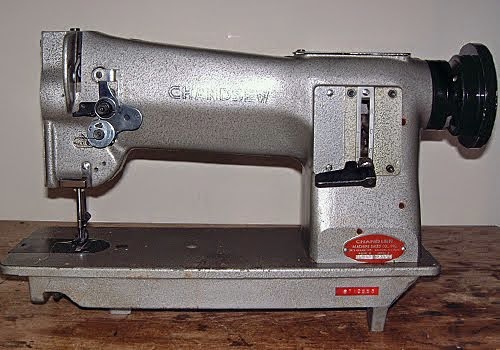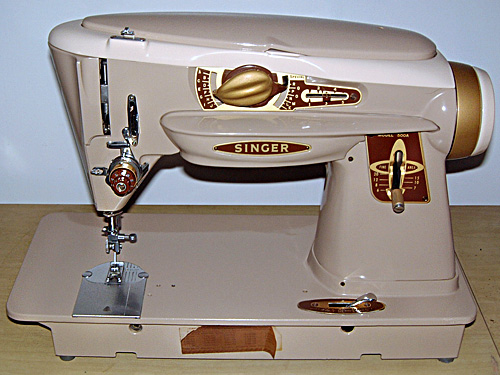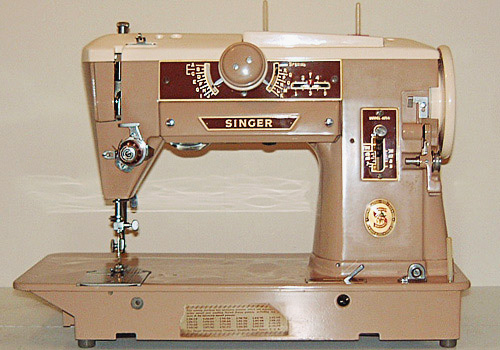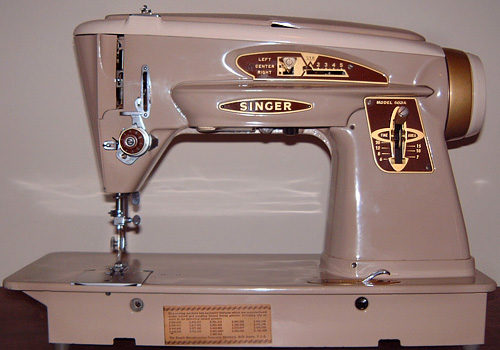Vintage Sewing
Buying, selling, servicing, using... thoroughly enjoying these marvels of mid-century domestic engineering.
Chandsew 406RB

Size Matters

Singer 153W103 Industrial

Singer 316G

Singer 301

A design revolution for Singer, this light-weight portable is a favorite with quilters. This example dates from 1951, but, interestingly, isn't badged as an anniversary model.
Singer 221- Featherweight

In remarkable condition. This one dates from 1956.
Singer 500A

Reassembled and polished.
Singer 401A

Singer 503A

I've had a number of examples from the 400 and 500 series pass through my hands now, and as testament to their quality, they have all been in very nice condition; none, however, has matched this beauty for its near pristine state of preservation. While even on the cleanest example one must forgive a minor imperfection or two, this classic from Singer exhibits none! Truly as nice as one could hope.
Saturday, May 18, 2013
New Directions
My interest in vintage sewing machines has taken a turn; I'm now enjoying those machines intended for industrial use - more specifically, those used for sewing leather.
My wife,Mary, was given quite a bit of upholstery leather and, in order to get the most out of it, I picked up a Consew 206RB-3 walking-foot industrial; not what one would call vintage, necessarily, but an older and well-made machine. Unfortunately, it took up more space than I felt able to allot it at the time and I sold it to a sewist who will make great use of it. I'm now back in that market, looking for another compound walking foot (I've since made room in my hobby room by lightening my collection of vintage domestic machines) after seeing Mary turn out a couple of leather pillows on her Singer 316. How much easier it would be to do that on a walking foot! I sometimes kick myself for having just sold the Consew before this revelation.
You'll note at the top of this page photos of my latest acquisition, a 1944 Singer 29K60 Patcher. I intend to run a few simple leather projects through this machine, but even if it doesn't prove practical, it's been fun to work on, a chance to learn something new, and reason to keep my hands in the game.
I learned early on that while collecting vintage sewing machines was an easy and enjoyable hobby, collecting cabinets wasn't a practical part of the plan; there was certainly no room for the many cabinets, tables and desks that came with the many machines that passed through my hands.
So, vintage industrials? Yes, with a nod to the obvious: no room at all for industrial-size tables with their massive weight and near immobility. I believe I'll have to focus on what enjoyment there might be in bringing the once tried and true, now old and tired, back to life, and see that they make their way into the hands of those who can make good use of them. I may keep one or two for the projects I'd like to do, but no collecting this time. I see a slower, more deliberate pace, and if I'm able to garner the fruits of light labor, in the way of a few successful projects in leather, then I'll count myself lucky to have taken this new path.
Sunday, October 21, 2012
A Look Back (and Forward)
It's been quite awhile since my last post. I've been concentrating more on buying and selling, so things have been busy in that vein, but not so busy in terms of collecting or using new machines.
One of my more interesting acquisitions has been that of a Consew 206RG-3 industrial, walking-foot sewing machine. Mary was given a good amount of leather, and while the Singer 316 (with walking-foot attachment) has been doing a good job of handling that, I thought a more robust machine was in order. I've made a couple of leather bags and have enjoyed the process, though I find I don't have time to delve too deeply into sewing. It is nice, however, to know that should any tough job come along, Mary has the power to get through anything. The servo motor I added sure made the learning curve less steep. Great machine.
Pictures in the blog will attest to other projects in the works, or completed. There's the Singer 'Red Eye" in the Parlor cabinet. It's surprising how nice a treadle machine will sew!
You'll note, too, the Singer 306 and Singer 319; such tough-seeming machines with a remarkable level of engineering and quality. They sure don't make them like this anymore!
And there is my latest: a Pfaff 230 Automatic – very impressive machine!
A few others have spent time on my bench: a Bernina 1230, a couple of Bernina 830s, another Bernina 730, and a number of cabinets as well. All 're-homed' for others to enjoy for years to come.
Prices have taking a hit this last year in the SF Bay Area. Many machines can be found for much less than would have been their asking price a year ago. Consequently, I'm focusing on higher-end machines with a loyal following; Berninas are always in demand, and rightly so. Those machines that are new to me, but are known to others as time-tested favorites, like the 306 and 319, are a pleasure to work on despite any difficulty in convincing others that mid-century, vintage machines are the way to go. It's plain that such quality will never be marketed again. In this throw-away world, the tried and true of yesteryear wins out in my book.
I'm looking forward to sharing with others the fruits of my labors –my latest finds – this Holiday Season, and hope for some success in getting into the hands of new owners some of the many interesting machines that spend time on my bench.
One of my more interesting acquisitions has been that of a Consew 206RG-3 industrial, walking-foot sewing machine. Mary was given a good amount of leather, and while the Singer 316 (with walking-foot attachment) has been doing a good job of handling that, I thought a more robust machine was in order. I've made a couple of leather bags and have enjoyed the process, though I find I don't have time to delve too deeply into sewing. It is nice, however, to know that should any tough job come along, Mary has the power to get through anything. The servo motor I added sure made the learning curve less steep. Great machine.
Pictures in the blog will attest to other projects in the works, or completed. There's the Singer 'Red Eye" in the Parlor cabinet. It's surprising how nice a treadle machine will sew!
You'll note, too, the Singer 306 and Singer 319; such tough-seeming machines with a remarkable level of engineering and quality. They sure don't make them like this anymore!
And there is my latest: a Pfaff 230 Automatic – very impressive machine!
A few others have spent time on my bench: a Bernina 1230, a couple of Bernina 830s, another Bernina 730, and a number of cabinets as well. All 're-homed' for others to enjoy for years to come.
Prices have taking a hit this last year in the SF Bay Area. Many machines can be found for much less than would have been their asking price a year ago. Consequently, I'm focusing on higher-end machines with a loyal following; Berninas are always in demand, and rightly so. Those machines that are new to me, but are known to others as time-tested favorites, like the 306 and 319, are a pleasure to work on despite any difficulty in convincing others that mid-century, vintage machines are the way to go. It's plain that such quality will never be marketed again. In this throw-away world, the tried and true of yesteryear wins out in my book.
I'm looking forward to sharing with others the fruits of my labors –my latest finds – this Holiday Season, and hope for some success in getting into the hands of new owners some of the many interesting machines that spend time on my bench.
Thursday, February 23, 2012
Spring Cleaning
Little activity on the vintage sewing machine front. I did sell a few machines over the holidays and into the new year, but, despite a considerable reduction in my prices, I've had few bites. Things may pick up later in the year when the warmer weather brings people out of hibernation.
I sold the Viking 6020. What a beautiful stitch that has. Alas, it isn't what I want in the stable of machines for Mary's crafting events. I'm pretty much settled on Singer Slant-O-Matics, Featherweights and 301's. These I can most easily keep in top running condition.
I did pick up a second Featherweight. While it did not have any extras or case, the price couldn't be beat. And, as it is in such nice condition, Mary leaves it out for general use.
The Berninas remain my favorites. I very much enjoyed working on them, found that easy to do, and I'm still impressed with their quality of design and build.
The Elna Supermatic is on the block. It isn't a machine that's easily transported as it uses a cabinet, so it isn't one that Mary will use at her events. It will make room for more projects that are more practical for Mary's crafting events.
I also sold the 401A that I had as one of my favorite machines. What a great machine! But I already have another 401 in near perfect condition, so letting that one go was more a matter of giving it a chance to make someone else happy.
And the Morse is gone! That was a tough one. It was in such great condition! But something had to give, and it wasn't getting the use it needed to "earn its keep". The lighter machines are those that are more likely to be pressed into service for Mary's events. I find that I'm rather tired after a day of transporting and setting up as many as twenty sewing machines.
The Pfaff 130 is staying. It won't be leaving the house. It's far too heavy to easily transport. What a nice machine! So remarkably stable. And it purrs...
I'm looking forward to Spring Cleaning – that which others do. I'll be out looking for projects and another round of buying, fixing, selling...
I sold the Viking 6020. What a beautiful stitch that has. Alas, it isn't what I want in the stable of machines for Mary's crafting events. I'm pretty much settled on Singer Slant-O-Matics, Featherweights and 301's. These I can most easily keep in top running condition.
I did pick up a second Featherweight. While it did not have any extras or case, the price couldn't be beat. And, as it is in such nice condition, Mary leaves it out for general use.
The Berninas remain my favorites. I very much enjoyed working on them, found that easy to do, and I'm still impressed with their quality of design and build.
The Elna Supermatic is on the block. It isn't a machine that's easily transported as it uses a cabinet, so it isn't one that Mary will use at her events. It will make room for more projects that are more practical for Mary's crafting events.
I also sold the 401A that I had as one of my favorite machines. What a great machine! But I already have another 401 in near perfect condition, so letting that one go was more a matter of giving it a chance to make someone else happy.
And the Morse is gone! That was a tough one. It was in such great condition! But something had to give, and it wasn't getting the use it needed to "earn its keep". The lighter machines are those that are more likely to be pressed into service for Mary's events. I find that I'm rather tired after a day of transporting and setting up as many as twenty sewing machines.
The Pfaff 130 is staying. It won't be leaving the house. It's far too heavy to easily transport. What a nice machine! So remarkably stable. And it purrs...
I'm looking forward to Spring Cleaning – that which others do. I'll be out looking for projects and another round of buying, fixing, selling...
Subscribe to:
Posts (Atom)